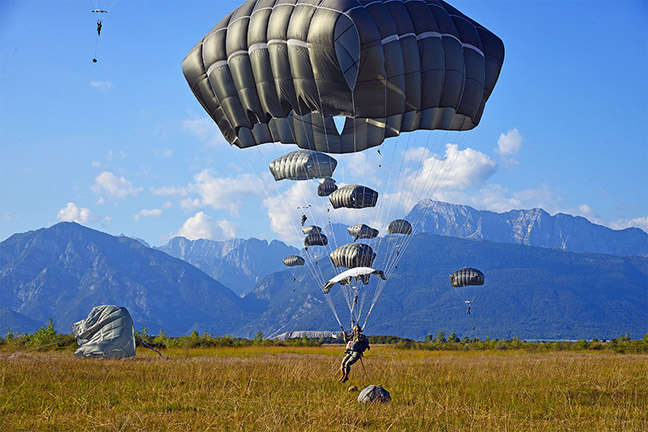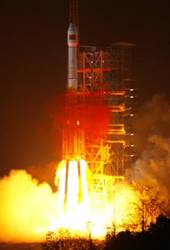The Army is kicking off a wide-ranging, five-year research effort to develop new position, navigation and timing (PNT) technologies for battlefield use.
The goal is to overcome technical barriers in a wide range of areas and military officials are offering to fund multiple, and even multi-phase, cost-plus-fixed-fee (CPFF) efforts to do that. The work may range from studies and analysis to development work that results in the production of a prototype-style deliverable or breadboard and/or a demonstration.
The Army is kicking off a wide-ranging, five-year research effort to develop new position, navigation and timing (PNT) technologies for battlefield use.
The goal is to overcome technical barriers in a wide range of areas and military officials are offering to fund multiple, and even multi-phase, cost-plus-fixed-fee (CPFF) efforts to do that. The work may range from studies and analysis to development work that results in the production of a prototype-style deliverable or breadboard and/or a demonstration.
Participation in the program is open to all organizations from research universities and start-ups to non-profits and large corporations. Those seeking support must go through a two-step process where they first submit a white paper of five pages or less describing what they are proposing. If the paper catches the interest of Army program managers the offerors will be invited to submit a full proposal for research efforts lasting up to three years. The final response date is November 30, 2022.
The Army is looking for solutions across 11 areas of interest though the emphasis is on technologies that will help warfighters operating in hostile radio frequency environments and GPS-denied areas. The proposals, wrote the Communications-Electronics Research, Development and Engineering Center (CERDEC), which is located at the Aberdeen Proving Ground, "may apply to operations both before and after the cessation of hostilities."
The Army is particularly looking for "approaches that address the very different challenges presented by urban fighting and dramatically enhance war fighter capabilities, for example, the ability to interact, maneuver, and operate under a time constrained environment. These changes should generally result in lower casualties, lower collateral damage, and the effective use of combat power."
The 11 research areas vary widely. The Army wants to improve the effectiveness of pseudolite systems with the goal of developing something that can be deployed in the near-term. Officials want to support and augment GPS signals when they are being blocked by obstacles or degraded or denied by adversaries. These systems could be used to aid acquisition of GPS satellite signals or, in severely degraded environments, as a source for positioning and timing. The technology sought ranges from software with analysis tools to aid in the positioning of pseudolites, advanced antennas, differential GPS corrections that could be sent over the pseudolites and alternative technologies for providing precise time and celestial navigation devices to serve as backup position sources.
The Army is also looking for advances in sensors and in inertial navigation technology that would support dismounted soldiers and vehicle navigation platforms that need to operate in denied conditions. This includes ways to lower the size, weight and power demands of systems as well as boost long-term performance.
The sensors sought could include vision-based navigation systems, light-detection and ranging (LiDAR) or radio ranging and velocity sensors. CERDEC is also looking for ways to combine information from multiple diverse sensors. This could include compressive sensing algorithms, plug-and-play architectures and solutions based on artificial intelligence, or AI.
CERDEC is looking for real out-of-the-box — or actually out-of-the-house — ideas too — that is, it is asking researchers to learn from the world’s best natural navigators. The Army is hoping for novel sensor designs based on the biomimetic processes ants, bees and migratory birds and fish use to find their way across vast distances.
In fact AI is a specific area of interest. CERDEC wants to identify, design, develop, and demonstrate the application of autonomy and/or AI technologies and techniques in each of the 11 research areas. This might include sensor fusion, as noted earlier, but also using AI to learn about the environment, routes, and sensor measurements to improve navigation accuracy and adapt to threats.
In further support of Vehicle Navigation System (VNS) the program is looking for researchers who can develop, design, and demonstrate ground vehicle mounted PNT systems. Again they are seeking near-term solutions for both manned and autonomous ground vehicles that work in denied environments. Solutions should be scalable and upgradeable including the ability to add M-code.
The Army also wants more methods for location determination and/or orientation using sources that are external to the platform. This could include Signals of Opportunity (SOP) like Wi-Fi or cell phone signals, radio atmospheric signals, radio navigation, celestial navigation and terrain matching. Ideas for using software or modifying hardware to enable standard GPS receivers to track non-GPS signals are also an area of interest. CERDEC is particularly interested in aspects of advanced receiver hardware including but not limited to new RF front end designs, non-traditional RF correlator configurations and designs, novel antenna designs, software defined GPS receivers as well as concepts that address integrity monitoring of the GPS signals themselves or of the GPS navigation solution.
Getting precise time in a denied environment is also an issue and the Army is looking for accurate timing sources and time transfer technologies to support mission command and decision making. This might include miniature atomic clocks, atomic frequency standards, and tightly coupled GPS receivers/clocks as well as wireless time transfer methods that can preserve time accuracy.
The modeling of all these new technologies is something CERDEC is hoping to advance. The Army wants to improve modeling and simulation to support design trade-off studies and assess performance of components and systems as well as systems of systems. Officials want to be able to better judge the impact of inserting PNT technology insertion into mission operations in various environments including as PNT relates to emerging threats.
The threat environment is the key issue, of course, and CERDEC is looking for NAVWAR technologies that will provide American warfighters with the ability to deny GPS/GNSS to adversaries while surviving an electronic attack against GPS.
The Army wants to identify, develop and demonstrate capabilities that can monitor, understand and control the Anti-Access Arial Denial (A2AD) environment on a battlefield. CERDEC is interested in innovative approaches for detecting spoofing attacks and locating interference sources. They are searching for technologies that assure unimpeded access to precise navigation information in challenging environments and that can selectively deny PNT information to adversaries while protecting PNT information to neutral/friendly forces.
The research solicitation, which was released November 24, is number is W56KGU-18-R-PN22. It can be found on FedBizOpps.gov.






